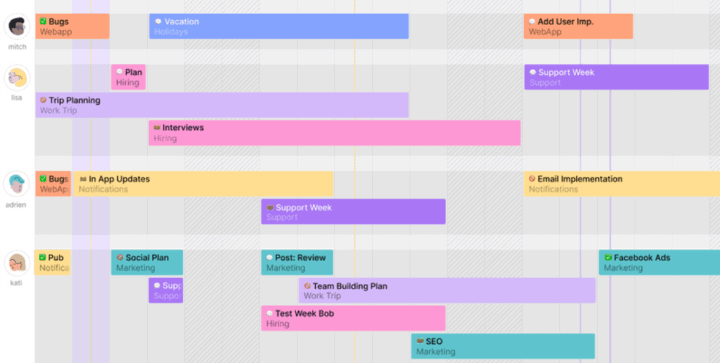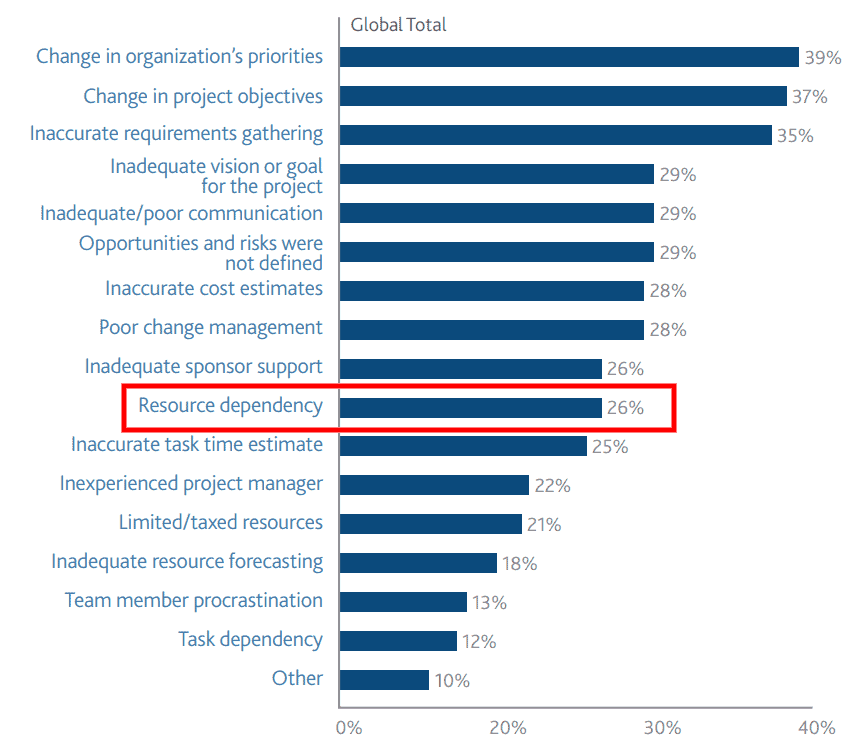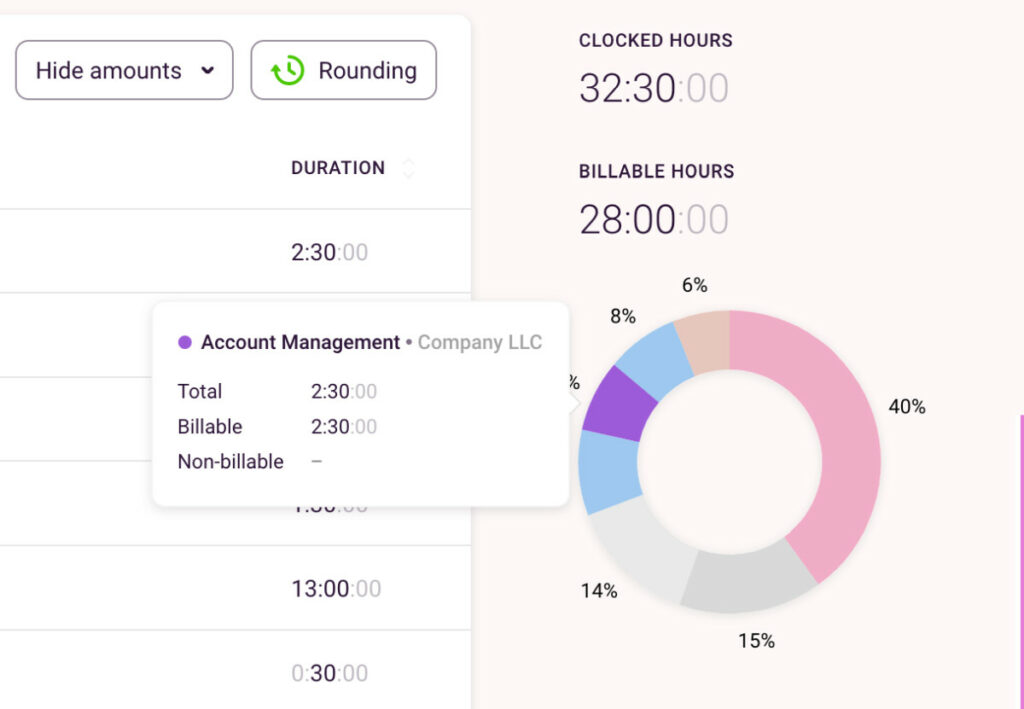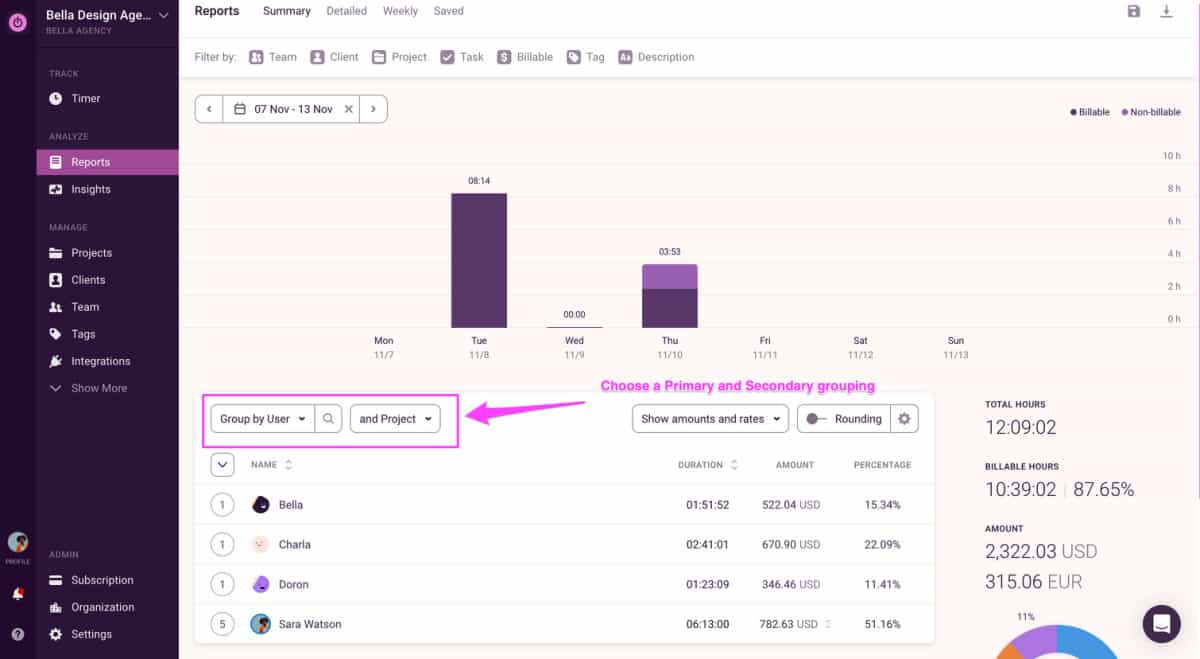Capacity planning helps you determine your agency’s ability to meet demand through your team resources.
By neglecting capacity planning, your agency faces two big problems:
- You don’t know if you have enough bandwidth to take on a new project or if you need to hire
- You don’t know if you’re utilizing their team profitably
At a company level, these problems slow down growth and reduce profits. And at the employee level, it causes overwork, exhaustion, and burnout.
This article is a comprehensive guide to capacity planning, including the benefits, the different types, the step-by-step guide, and the seven best practices to polish your process to a shine.
What is capacity planning?
Capacity planning is the process of determining an organization’s capacity to meet demand. For agencies and consultancies, it essentially means determining if they have enough people available to deliver their client projects.
Proper team bandwidth planning tells you:
- When and if you can take on new projects
- If you need to hire more workers
- If you’re utilizing your team optimally and profitably

Learning strategies to plan your team’s capacity helps you to make better decisions to increase efficiency and productivity. And if those just sound like buzzwords, remember that 11.4% of resources are wasted due to poor project management practices.
Do we have your attention? Then let’s proceed.
The three types of capacity planning
There are three types of capacity planning depending on the industry and project:
- Workforce capacity: Compares available employee hours to the total workload
- Tool capacity: Assesses the tools and equipment needed to deliver future work and projects
- Product capacity: Plans the inventory of products and materials you need to deliver work and meet demand
Of these, only workforce or team capacity is the most relevant one for agencies so it will be the primary focus of this article.
Capacity planning vs resource planning
It’s a pretty common mistake to confuse capacity and resource planning, so let’s quickly compare the two.
Planning capacity is a company-level practice that impacts the overall budget and staff. Its focus is supply and demand.
This is why it’s typically the responsibility of the top management.
Resource planning, on the other hand, assigns resources to specific projects and gives individual project managers an idea of which resources will be available and when.
So resource planning is the responsibility of the project manager.
Here’s a quick side-by-side comparison:
| Capacity planning | Resource planning |
|---|---|
| A company-level practice focused on supply and demand | A project-level practice focused on resource allocation |
| The responsibility of: • The business owner/CEO in small businesses • People ops CXO/director in large businesses | The responsibility of the project manager |
Capacity planning vs capacity management
The difference between the two is plain in the two words: “planning” and “management.”
Planning refers to the preparatory work done beforehand to forecast future work demand and plan the necessary capacity to meet it. On the other hand, capacity management involves monitoring and analyzing ongoing capacity to ensure your plans play out as you wanted.
Also, bandwidth planning is done periodically and upfront. Whereas, capacity management is an ongoing practice to ensure that the planned capacity is met.
Here’s a quick summary:
| Capacity planning | Capacity management |
|---|---|
| Based on the forecasted work demand | Based on planned capacity |
| Centered around creating a roadmap to determine if an organization’s capacity can meet its customer demands | Takes actions to ensure the organization meets planned capacity needs |
| Top management is responsible | Responsibility of: • People ops teams • Project managers and team leaders |
Benefits of capacity planning
Let’s take a quick look at why you should focus on planning your agency’s capacity:
Optimizes resource utilization
Thoroughly planning your capacity needs optimizes resource utilization.
In simple terms, you minimize excess capacity and use your resources more efficiently to become more profitable.

Better resource utilization also reduces overwork and employee burnout.
Employee burnout is a serious issue that affects the quality of work and retention. Easing burnout in your team helps improve morale, motivation, and engagement so your work goes more smoothly.
For more tips on burnout, see our blog on recovering from burnout.
Keeps an inventory of required skills
When planning your team’s capacity you’re also documenting all the roles and skills you need to effectively execute a project.
For example, a content writing agency’s current capacity is seven clients, with eight writers, four editors, and two project managers.
This gives you a quick average of the skills, positions, and the number of resources you need per client, and this knowledge helps you plan for the future, making upcoming projects quicker and easier to plan.
Helps you make more informed talent acquisition decisions
When you plan your capacity for new projects and clients, it gives you valuable information on what talent you’ll need to complete them.
Essentially, it backs up hiring decisions with concrete historical data.
So if a design agency determines that one client needs three graphic designers and they currently have five, they know that taking an additional client will require them to hire one more designer.
Helps you complete projects on time and to a higher standard
It’s always hard to say no to new clients. But taking on too many clients can result in overload.
You end up overworked, burnt out, and without enough time to finish projects to client satisfaction.
And only 52% of projects are delivered to stakeholder satisfaction on average anyway, even without the burnout.
When you assess your capacity and get it to a comfortable level, you’re basically biting off the exact amount you can chew.
That way, you can complete the project to the best of your team’s ability, which leads to happier customers and stronger client relationships.
Ultimately leads to better margins
Taking on the right amount of projects and clients, reducing employee burnout, and utilizing your team at top efficiency simply leads to better profit.
So really this point rolls several benefits into one.
You can take on clients when you’re ready for them and have a team that produces high-quality work that makes some seriously good money.
The 3 capacity planning strategies
Depending on the forecast of your target market, skill availability, and your agency goals, there are three types of capacity planning strategies.
Lead capacity strategy
This strategy involves aggressively increasing capacity in anticipation of future demand.
The advantages of lead capacity planning include having the resource capacity to meet sudden demand surges. If it works out well, it gives you an edge over the competition.
Its primary disadvantage is that it often results in underutilized capacity.
This type of strategic planning is most useful for businesses that anticipate a busy season in the short-term (possibly historically busy), so they plump up their staffing in advance. For example, an e-commerce marketing agency may need more marketers during the holiday season.
It’s also common for such companies that work with contractors and freelancers, instead of staffing. This reduces the risk of underutilizing your team.
Lag capacity strategy
In the Lag capacity strategy, companies increase team capacity in response to demand i.e., an increase in work.
This is the safe, low-risk option, as you aren’t increasing capacity before you see a need for it.
The main disadvantage is that it’s often impossible to find and hire knowledge workers at the eleventh hour. As a result, teams are overworked or projects get delayed.
A lag strategy is best for smaller companies or in a recession market. This strategy helps you maintain a healthy cash flow and prevent layoffs.
Match capacity strategy
This strategy is a bit of both — Lead and Lag strategies, but it can be tricky to master.
It involves increasing capacity in small increments in anticipation of demand—in other words, demand is starting to surge, so let’s hire some new talent.
This means you need to monitor market trends and analyze previous project data, which makes access to good historical data a must. Time tracking software is very handy to obtain this historical data so you can gauge future demand.
However, since match capacity planning aims to match your available capacity to your demand, it needs near-constant incremental adjustments, meaning a whole lot of work.
This makes it useful for most situations but effort intensive, so it’s ideal for agencies that can dedicate resources to implement this strategy.
How to do capacity planning in 4 steps?
Let’s get to the meat of this blog, starting with the step-by-step how-to capacity planning guide, then the capacity planning best practices below.
Summary
| Step | Description |
|---|---|
| 1. Measure your current capacity | Identify and note down your team’s skills, working hours, and availability |
| 2. Forecast demand | Study current projects, upcoming projects, and industry trends to determine your future demand |
| 3. Identify resource gaps | Compare your current capacity to your forecasted demand and see if you have resource gaps |
| 4. Choose a capacity planning strategy to bridge your resource gaps | Pick the capacity planning strategy that suits you and bridge the gap in your capacity |
1. Measure your current capacity
Start by looking at your current capacity and skill sets. This means looking at your team, their working hours, and their skills.
A simple formula for calculating your team’s capacity is:
capacity = number of people x working hours x utilizationWhat is utilization? It’s the share of productive (or billable) working hours excluding work about work, such as meetings, training, sending emails, etc.
Let’s say, your team has 12 people on it working 40 hours a week. You assume a utilization rate of 75%.
Based on the above formula, the weekly capacity of your team is:
weekly capacity = 12 x 40 hours/week x 75% = 360 hoursKeep in mind that this capacity can be different based on the skills your team members bring to the table. So you want to record the job roles/skills along with their respective capacity.
2. Forecast demand
Forecasting the “demand” side of “supply and demand” involves three main things:
- Looking at your current projects
- Looking at upcoming projects and estimating their requirements
- Taking an educated guess depending on your business, industry, market, etc.
Historical data from your time-tracking software can help you find this info—that way you can also see your growth over the last few projects and see how steady your resources have been.
Have you gained three new clients in the last four months? If your future projects and plans look similar, it’s possible that this level of growth will continue.
The key to this step is getting a rough estimate on upcoming resource requirements so you can determine where you currently stand.
3. Determine required capacity and identify resource gaps
Now you can take your current capacity and the estimates of your future capacity and determine the required resources and skills.
So you’re going to ask yourself: “Do I have enough resources to tackle more projects?”
Generally, this measurement will be done in hours, but some agencies measure capacity by units. For example, a content writing agency example from above might measure capacity by the number of blog articles.
After measuring, does your current capacity meet future demand? If not, where does it fall short?
Try to quantify it in the number of resources, amount of time, or skills.
Let’s say this agency forecasts that they’re going to need the equivalent of four writers in order to take on this new client. But two of their current writers aren’t being utilized to the fullest—so they can take on half of the work.
So that means that to take on this project, the capacity needed is 2 team members, and the skill needed is content writing.
4. Choose a capacity planning strategy to bridge your resource gaps
Now it’s time to choose one of the capacity planning strategies we mentioned above to bridge this gap.
Which strategy you choose depends on your organization’s particular needs, processes, and size.
Let’s quickly recap the three types of capacity planning strategies and when it’s best to use them:
- Lead: Aggressively increasing capacity in anticipation of demand — ideal for any historically busy period of time and companies that hire low-risk contractors and freelance workers.
- Lag: Increasing capacity only when you experience growth — ideal for small businesses with slow growth that can’t risk locking up capital in resources.
- Match: Increase capacity to match demand — ideal for big agencies that can dedicate resources to planning capacity.
As you begin to bridge your resource gaps, utilize tools like kanban boards and Gantt charts to make it simpler to organize.
These tools allow you to visualize your resources, their time, and their role in various projects.
Projects and teams are made up of dozens of little moving parts, so it helps to have it all neatly mapped out.
Capacity planning best practices
A quick summary of the best practices is given in the table below.
| Strategy | Description |
|---|---|
| Look at your capacity from multiple angles | Consider a broader idea of your resources, like skill sets and hours, not just the number of people |
| Make capacity tracking and demand forecasting an ongoing exercise | Build capacity planning and monitoring into your culture and make it second-nature |
| Consider multiple solutions to plug resource gaps | Consider options including freelancers and contractors to fill resource gaps |
| Cross-train your employees and make them multi-functional | Equip your team with multiple skill sets to increase their range of use |
| Identify and eliminate workforce capacity bottlenecks | Monitor resource time and tasks to discover productivity bottlenecks and solve them |
| Remember that your resources are people and not machines | Add contingency time to your capacity estimates to account for humans being humans |
| Use a software tool to plan capacity | Utilize a capacity planning tool to make planning easier and more accurate |
Let’s dive into the details now.
1. Look at your capacity from multiple angles
It will pay dividends to look at your capacity in different ways.
Consider your resources in different ways, like:
- Total number of resources
- Work hours
- Seniority
- Skill sets
- Costs
Broadening your idea of resources and considering every angle helps prevent little mistakes that aren’t so little once you’re deep in a project (e.g., realizing too late that you have a huge gap in WordPress development skills).
In this case, you have the people and the hours but not the skill. Maintaining an open mind about all the factors that go into “capacity” can prevent this kind of headache down the road.
2. Make capacity tracking and demand forecasting an ongoing exercise
Capacity planning seems like quite an undertaking. But like all things, it gets easier the more you do it.
So weave time-tracking, monitoring, and forecasting into your regular practices and company culture.
Make it a continuous practice that’s done before every project and new client.

This will be much smoother if your team is used to tracking their hours with software or spreadsheets. Then you can check reports during and after projects to check how long a project took, the total utilization of your team, and how close they were to your estimates.
Making this a regular process does two important things:
- Enables you to keep up with your demand and resource management
- Solidifies capacity planning as a normal part of your routine (which ensures it gets faster and easier)
Plus, the more you do it, the more accurate your historic data will get, which improves your project plans and estimates.
3. Consider multiple solutions to plug resource gaps
There’s more than one way to solve that resource gap.
And considering all your options before acting is a good idea when the cost of hiring an employee is so staggeringly high.
Yes, you can still hire fulltime employees. But don’t forget other options, like hiring freelancers or contingent workers or outsourcing certain tasks.
Freelancers can be an excellent solution, especially if you’re strapped for time.
There are some solid perks to hiring contractors and freelancers:
- Faster hiring, onboarding, and training process
- Easier access to specialized talent
- No need to pay for benefits and taxes
Outsourcing tasks to a third party is another option to consider. When you outsource certain roles or tasks it can reduce costs (depending on where you outsource), increase speed, and offer high flexibility.
4. Cross-train your employees and make them multi-functional
Having team members with multiple skill sets increases their efficacy as resources. They can cover more roles and help your organization become more nimble.
You’ll have less to worry about resource-wise, because even if you overshoot one role’s prominence, that worker could be used elsewhere.
For example, if you have a writer that also knows how to edit, you’ll be able to fill a needed editing skill gap even if their writing skills aren’t currently required.
This is one of the many reasons that investing in employee training and development is worth your time. Upskilling reduces turnover and keeps worker satisfaction high.
5. Identify and eliminate workforce capacity bottlenecks
Monitoring your capacity helps you spot little inefficiencies or bottlenecks that could be a serious spanner in the workflow.
Checking your employee time reports might show way too many hours spent on tedious, time-consuming tasks that don’t give enough value for the time frame required to do them.
Here’s what that looks like in Toggl Track:

After a bottleneck is discovered, there are quite a few things you can do:
- Delegate the task to an employee with a lower billing rate
- Delegate the task to an employee who’s faster and more efficient at that task
- Streamline and optimize the task by removing what’s unnecessary
- Talk to the client about how important is to them and ask for more budget if necessary
6. Remember that your resources are people and not machines
Your resources are people, so they won’t be working at 100% utilization for their entire 40-hour weeks.
People aren’t machines and won’t be able to use every minute efficiently. There could be sluggish days, emergencies, or days where they simply aren’t running at the perfect speed.
And expecting them to run at top speed every working day will only cause burnout.
It’s important to always add contingency time into your capacity planning strategy. If your plan requires every last employee hour in order to fill the resource gap, you’ll need to reassess your strategy.
7. Use a software tool to plan capacity
Keeping track of your team’s capacity can be complicated. The best way to make the process easier on you is to let the right capacity planning tools lend a hand.
77% of high-performing projects use project management software. The right PM software will facilitate following planning your team’s capacity with:
- Team scheduling
- Workload management
- Project timeline planning
- Time tracking
- Reviewing past project reports
Capacity planning examples
To help you understand things better, here are two simple capacity planning examples.
Example capacity plan for a content writing agency
Let’s use a small content writing agency with 10 writers. Say each writer delivers 2 articles/week.
Weekly capacity = No. of writers x No. of articles per writer per weekFor our hypothetical content writing agency the weekly capacity comes to be 20 articles.
The agency then examines demand and determines that if they take on the new client they’re talking with, their total demand will be 24 articles.
This means they have a resource gap of four articles.
To fill this gap, the content writing agency can apply any of the three capacity strategies we discussed above.
| Strategy | Actions |
|---|---|
| Lead capacity | • Hire two new writers |
| Lag capacity | • Wait until the new client comes on board • Only then hire new writers or freelancers • Utilize the existing writers until then to bridge the gap |
| Match capacity | • Cultivate relations with freelancers • Become a preferred employer brand among writers • Hire them as soon as the new client is on board |
Example capacity plan for an IT consultancy
Let’s consider a medium-sized IT consultancy with 60 employees.
They use the match strategy and closely monitor capacity and resources, making small changes in real time.
In their last project their teams had an average 88% utilization rate—and experts recommend a utilization rate of 70% to 80%—so they decide to plug the predicted resource gap.
The consultancy realizes that if business continues at this rate, they’re going to need more project managers and more DevOps engineers, as they’re the resources being pushed the furthest.
This not only helps ensure the success of future projects but helps prevent the (very possible) burnout of these resources.
Capacity planning for stronger projects and a happier team
A proper capacity planning process enables you to confidently take on new clients, grow your business, and complete bigger and better projects.
Just follow our four-step capacity planning guide:
- Measure your current capacity and record your current skill sets
- Forecast demand
- Determine required capacity and identify resource gaps
- Choose a capacity planning strategy to bridge your resource gaps
And don’t forget to weave a few of our best practices in, too. The goal of capacity planning/tracking and solid capacity planning software is to make everything easier in the end.



![10 Top Paymo Alternatives for 2024 [Full Comparison]](https://toggl.com/blog/wp-content/uploads/2024/02/paymo-alternatives-746x394.jpg)